|
|
Post by codystarbuck on Oct 18, 2016 13:09:25 GMT -5
Another series I should re-read. I think I have all of the originals, as well as the 80s reprint. There's a fairly rare edition that came out in '79. I remember thinking at the time that $8.50 was pretty pricey for a B&W book. Not a DC product, so I don't know what kind of deal was cut for it. www.comics.org/issue/682152/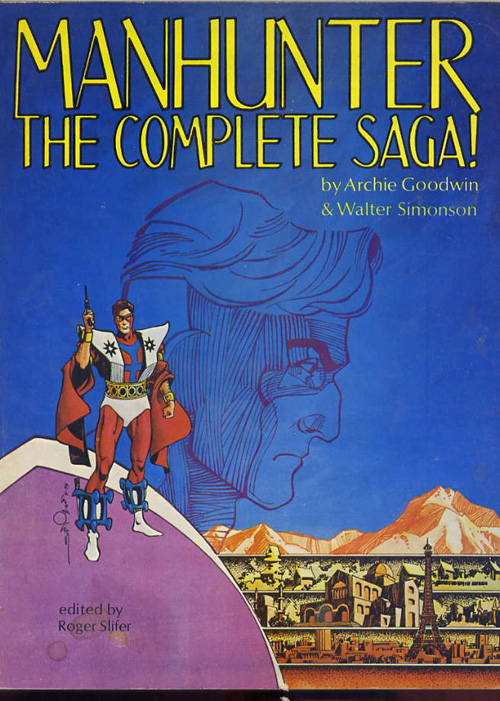 I found out about that thing well after the fact. There have been a couple of black & white reprint things, from the early days of the direct market. I think the scale was usually small enough that DC was okay with it or else okayed a very small print run. No idea about this specific case, though. The special edition trade book is the ultimate, for me, since it has the silent story coda. I just wish they had used better quality paper and given it a hardcover binding. If I'm not mistaken (I haven't actually seen it) I believe the Archie Goodwin Batman book has the whole thing, though I don't know about the silent story. |
|
|
|
Post by chaykinstevens on Oct 18, 2016 14:45:58 GMT -5
According to GCD, Tales of the Batman: Archie Goodwin does include the silent final chapter. link |
|
|
|
Post by codystarbuck on Oct 19, 2016 14:36:18 GMT -5
Chapter 3, "The Resurrection of Paul Kirk." 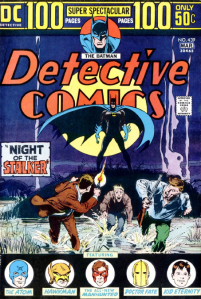 First off, this is one of the best covers of the 100-pg Detective issues and features one of the best Batman stories, from Steve Engelhart and Sal Amendola. Greg Hatcher, at the CSBG blog (RIP {the blog, not Greg, who is at the Atomic Junk Shop}), covered this quite well, which led to contact from Sal Amendola, which he shared here: www.cbr.com/more-deja-vu-with-sal-amendola-and-the-night-of-the-stalker/ I got a tremendous ego boost when I made a comment about Greg and his teaching work, which Sal seconded. It's pretty cool when someone whose work you have admired affirms your opinion of something. Anyway... Here's the reason we are here: 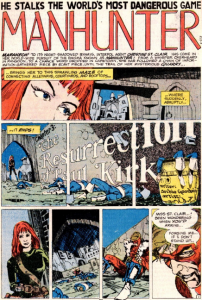 How's that for an intro page? Great Kirby, that's awesome! It's not just the art, check out Archie's narration. "Marrakech! to its night-shadowed byways, Interpol agent Christine St Clair has come in her worldwide pursuit of the enigma known as Manhunter! From a whisper overheard in Rangoon, to a chance word dropped in Capetown, she has followed a chain of information gathered piece by scant piece, until the trail of her mysterious quarry brings her to this sprawling maze of connecting alleyways, courtyards, and rooftops...where suddenly..it ends!" We don't see any of this happen; but, Archie paints the picture in our minds, via the names of exotic locales. We can imagine Christine in dingy saloons, back alleys, wharfs, run-down hotels, searching for the barest trace of her quarry. We can imagine her trading money for information, or based on Walt's image of her holding a pistol, decked out in her action gear, beating it out of them. This tells us much about this very capable lady. Walt isn't slacking off here, either. We get a tight shot of Christine's eyes, with a hint of the close quarters in the background. We then see her in an archway, a hint of light behind her, as she surveys up an alley, littered with bodies in blue and white uniforms (leading us to a barrel, with a body slumped in it, which features the story credits, on the side). Finally, we get a 4 panel progression: close-up on Christine, holding a pistol; long shot of a slumped body,leaning against a wall; close-up of the wounded Manhunter, appearing to be dead; tight close-up on Manhunter's face as he responds "Miss St. Clair....been wondering when you'd arrive....forgive me if I don't stand up..." The cinematic storytelling is on full display here. Archie and Walt are telling us everything we need to know about the battle that happened here, without showing it. We have 5,(apparently) dead bodies along a wall, a view of bodies, creating a path of death that leads to Manhunter and a shot of a man who looks like he has fought the forces of hell and is still, amazingly, alive. This must have been an epic fight; but, Archie, a cunning storyteller if there ever was one, aided by Walt, who is no slouch in that department, wisely leave this to our imaginations, where it is greater than any pen could ever do justice. That's confidence. Most writers and artists would have shown this, to say to the readers, "See what I can create?" Archie knows this will make the story more intriguing and keep you reading. The mark of a good storyteller is knowing how to get the audience to say, "And then what happened?" The story moves forward, as Christine wants to get Manhunter a doctor; but, he says he just needs time to heal. Take that Logan! He proceeds to give his Mauser to Christine, telling her more men will be coming, then offers to tell Christin all she has been searching to understand. He takes us back to the late 1930s, when he was a big game hunter, the best of the breed. He had grown tired of hunting animals and decided to pursue a deadlier game, man! Following the lead of the emerging mystery men, he dons a costume and stalks criminals as the masked Manhunter. This is where we have our art shifts, between the original Detective #439 and the later Baxter-format reprint. But, in the words of Peter David, I digress... Kirk tells Christine that his costumed adventures were sidelined by the war, where he became a special operative of the government, working behind enemy lines, performing the most violent and ugly jobs. Walt just gives us a hint of all of this in a montage; but, it is enough. We can imagine the nasty things Paul did in the war, in service to stopping the Nazis. We believe he was an effective hunter, as we have already seen him defeat men and animals, with his previous slaying of a tiger. Paul goes on to say, after the war, he returned to hunt in Africa; but, his heart wasn't in it. He had seen too much death and violence. He was tired and weary . he deliberately misses his shot, and it brings and enraged bull elephant charging through the brush, leaving Paul with only his rifle to try and stop the charge. he doesn't fire. he basically tries to commit suicide via elephant. It nearly succeeds. Walt gives us an amazing image as we see a close-up of Paul's eyes, as he sees the elephant rampaging towards him; but, there is a sadness in his eyes, more than fear. This is followed by the elephant, with red eyes, crashing into Kirk, his body flying, bent across the massive tusks. We see his battered body face down on the ground, while Archie's narration speaks of a sound, "like the wings of the Angel of Death." This page tells us that Paul Kirk, a man who had seen far to much death and destruction, should have died and known the peace of the grave. This is then juxtaposed by a new wave of blue and white-clad men attacking the alleyway, as Christine guns them down, a pistol in each hand. Manhunter compliments her, telling her she is very good. She replies that she is trained to be. In 4 panels, we learn that Christine is a very deadly woman, not just a lowly investigator. This is someone who is on par with the hero. Paul continues the story, telling us that the angel turned out to be a helicopter that came and found him and whisked him away. We learn of advanced medical treatments that saved his life, while keeping him in stasis, as time passes. he awakes to find himself whole and healed. An older man tells him of what has occurred and presents him with a red and white uniform. He explains that the fantastic sights Paul is seeing is the headquarters of a mysterious Council. The speaker is Dr Mykros, a man who Paul rescued from the Nazis, in 1945. Paul asks about the Council and Dr Mykros explains that they are ten of the best minds in the world, who at the end of the war banded together to save the world from itself, in the wake of the atomic bomb. They saw the potential for ultimate destruction and decided to act. These two pages feature a dizzying array of images. We see an almost monstrous image that morphs into a helicopter, carrying the limp body of Paul Kirk, reminding us of the opening of MASH. We see science fiction machinery used to keep Paul alive. In a single panel, we see the progression of history, from atomic bombs, to Kennedy, to Vietnam and the shooting at Kent State. We see Paul awake from decades of slumber and a complex right out of a James Bond film. We learn of a secret society, dedicated to protecting the world. Again, pulp storytelling at its finest. We are left with questions; how did the Council know where Paul was? How did they achieve this miracle? If they are society' s protectors, who are the men attacking Manhunter, who bear his face and a similar uniform? Christine kills more attackers, musing that the Council must have a rival faction, who set their opponents against them. Paul tells her to look closer at them. They are like brothers. He explains that they are the Council's enforcers. Walt gives us a perfect piece of shorthand to describe the relationship, as we see a tight close-up of Paul's face, racked with pain, and a side bar of repeated faces, connected by a frame, reminding us of pieces in a plastic model kit. He describes what these men are: clones of his own body. They are genetic duplicates, creating an army to serve the Council. Paul was selected to lead them. Paul questions the use of the men and wonders what happens if they are used wrongly. Mykros says they have the best minds of the era and that can't happen. Paul is more cynical, citing the nature of human beings. His concerns are dismissed and he is introduced to an older Japanese man, Asano Nitobe, master ninja. Again, Walt uses a montage of images to convey the vastness of the complex, the depth of the clone army (as they train in hand-to-hand and weapon combat), and his relationship to his would-be assassins. The scene returns to Christine firing at their attackers, remarking that Nitobe was supposed to be dead, killed in the atomic bomb blast at Nagasaki. Kirk informs her that he actually survived, secretly acting as bodyguard to Dr Oka, a geneticist who became a member of the Council. After relaying this information, Christine finds that she is out of ammo. We see a trail of bodies leading up steps, to where Christine and Paul are fortified. Paul continues, talking of his training. Walt gives us silhouetted snapshots of men in battle, emphasizing martial skills. He then gives us quiet moments, between Paul and Asano. Then, we see Asano tell Paul that he is ready, then he fires an arrow into Paul's shoulder. He yanks it out and tells Paul to concentrate on the wound. It heals itself. Asano tells him about the abilities, a product of Dr Oka's work, as were the clone enforcers. He then briefs Paul on his first mission: the elimination of an Interpol officer. Paul is stunned and questions the choice of words. he is troubled and wishes to address the Council. Asano tells him to do so; but warns him that he is in the Council's hands, using a proverb: "In the tiger's lair, the only justice belongs to the tiger." The attack seems to have ceased and Paul is standing, apparently healed of his deadly wounds. A voice cries out not to shoot, that he is coming up. Christine recognizes it as her boss Damon Nostrand. Christine is happy to see him, until she sees his gun pointed at them and listens as he tells them how foolish they are. manhunter reacts, throwing his knife into Nostrand's arm, forcing him to drop his pistol and flee. Christine then puts two and two together and says that the assassination mission was to replace Damon with an imposter. Paul tells her that there is more to the story and he will relate it, while they pursue Nostrand. So, we have another thrilling chapter, with some of the blanks filled in. Manhunter IS Paul Kirk, a former hunter, mystery man, and spy/commando. He was a man tired of killing, who sought the peace of death, only to be saved by a mysterious group of scientists, dedicated to saving the world from itself. We learn that the other Manhunters, who have tried to carry out assassinations and kidnappings are his clones, an army created for him to lead. We learn that this Council thinks themselves unfailable, yet Paul had doubts. We learn he was trained by the world's greatest martial artist and master ninja. And, we learn that Christine's boss is connected to the Council, or at least impersonated by one of their agents. Yet, there is more to know. This chapter mixes in elements of the great pulp heroes, like the Shadow and the Spider, and the cinematic pulp of James Bond, with secret complexes, mysterious global organizations, and armies of men training for battle. In the middle of it is a guy dressed like a superhero, with a woman who could be a sister to Emma Peel and Modesty Blaise. Again, 8 pages have given us an epic tale; but, it is only a chapter in a bigger story. 8 pages, not 8 issues. Archie knows less is far more. Give us a taste and we will come back for more. Walt gives us the important shots, plays with time, and lets our minds fill in the gaps. He gives us breathtaking action, without wallowing in gore or gratuitous violence. We get the impact; but, are spared the gore. Walt gets to show us Africa, with its wild savannahs and wondrous animals. We see dark and mysterious Marrakech, fabled city of intrigues and murder. We see science fiction installations and machinery, and the simple, brutal martial arts. We see violent and quiet moments. And, as we look over this, over 40 years later, we remember that Walt was just starting out! This is where the legend of Walt Simonson began. This is where Archie Goodwin put his already lauded stamp. This is a back-up tale that was outshining the lead feature and the lead had one of his best stories of the decade. Now that's a comic book! |
|
|
|
Post by codystarbuck on Oct 20, 2016 22:42:27 GMT -5
Chapter 4, "Rebellion" Well, I got a little long winded last time; but, danged if that wasn't an awesome chapter. This one will be more concise. We can take as read that Archie and Walt will speed up and slow down the action with the panel layouts, that it will be cinematic, and Archie will paint pictures with words and Walt will write poetry with images. Here's the cover to Detective #440: 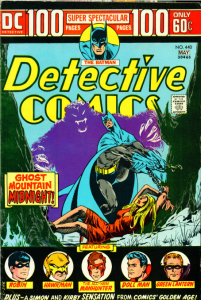 Pretty cool and creepy stuff, from Jim Aparo. As we can see, Robin , Hawkman, Doll Man, and the original Green Lantern also appear. Manhunter appears, twice! Not only do we get a new chapter in our epic story, we get a reprint of a Simon & Kirby Classic. I'll get to that in a bit. First, a bit of an origin tale. In 1984, at the tender age of 17 (my birthday is in November, so I didn't hit 18 until I was already at college), I went off to the University of Illinois. While there, I discovered my first comic book shop, the long gone Book Nook. It was a comic shop and used book store, run by a guy who was both a major comic fan and Doctor Who nut. He used to appear, with the local Dr Who appreciation society on the local PBS station (WILL-Champaign), during pledge drives, when they would run Dr Who marathons. But, this tale isn't about him. In that sho I discovered old favorites from my childhood, for an average price of $.40. I also found some stuff I used to see in house ads; but never owned. On of these was the 100-PG issues of Detective. Sometime, in 1973 or 74, I saw a house ad with one of the Detective issues featured and saw the face with the name Manhunter beneath it. I had no idea who he was and it stuck with me. I had no idea, when I entered the shop, who Manhunter was, still; but, I found Detective #440 in the boxes. I snatched it up and went back to my dorm to read it. The Batman story was good; but Manhunter was something else. It started my fascination with the character. That 8 page story had me jonesin' for more; but, there weren't any other issues in the store. Meanwhile (later in the school year), I came across a book in the student union bookstore, The Comic Book Heroes, by Will Jacob and Gerard Jones. It was filled with a fan's-eye history of the Silver and Bronze Age. There was a chapter about the 70s Batman, which went into great detail about Manhunter. I really wanted to read this now! I went to school on a Navy ROTC scholarship, which meant that I spent a month of the summer on active training duty. When I came back, pockets flush with cash (I got regular pay while on training cruise!), I went to a comic shop in St Louis (where my mother was working, while my father was still at home, finish his time as a school teacher, before he could retire). There, on the wall, I saw the Baxter-format Manhunter Special. You know I bought it (as well as the first appearance of Warlord, in First Issue Special). Now I had the whole story. My fascination grew and I would go on to collect the individual Detective Comics chapters, the later trade book, and the Secret Society of Super-Villains (because of the Manhunter clone), as well as the Kirby Mark Shaw story from First Issue Special #5, the JLA issues with the Manhunters and Mark Shaw (as a Manhunter and the Privateer), Millennium, Suicide Squad, and the Manhunter regular series. I love this character, because of this one little comic we see up top. Anyway, our story finds Damon Nostrand on the run, after being wounded by Manhunter's throwing knife. He s speeding down an alley, in a land rover. He comes upon Manhunter and Christine St Clair, who have been pursuing him. He roars towards them, hoping to run them down. We get what is probably the single greatest page in the entire saga (here's the top half, couldn't find a picture of the bottom) 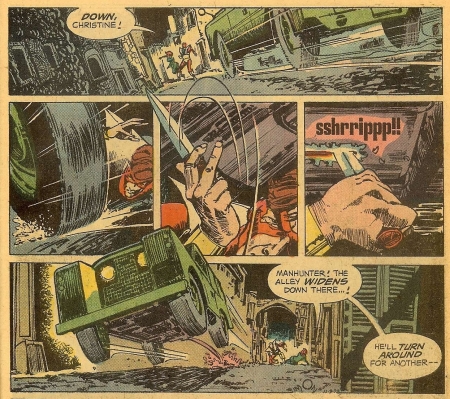 Manhunter drops beneath the jeep, whips out his knife, slicing open the gas tank. As the jeep speeds away, he lights a match and tosses it into the gasoline trail, setting off an explosion. Cinematic as all hell! The rest of the tale finishes Paul's origin, as he confronts Dr Mykros about his mission and receives a rather heated reply. He goes off on his mission; but, instead tries to warn his target, Damon Nostrand. He then learns it was a test of loyalty and Nostrand is a Council agent, who is backed up by Manhunter clones. Paul fights his way out of Nostrand's apartment and goes on the run. He makes his way to Kenya, where he finds Kolu Mbeya, the son of an old hunting friend and a weaponsmith. Mbeya is tasked with creating Manhunter's arsenal, and we get our ful first look at his gear:  The story finishes and Manhunter and Christine survey the wreckageof Nostrand's land rover, where they find his hotel key. They go to his room to search for clues about the Council and find wanted posters for the pair of them, sent via Interpol networks. Not only do they have to worry about the Council, they have the entire world's law enforcement agencies looking out for them. Archie and Walt say goodbye to one character and give us a new one, Kolu Mbeya. In 5 panels, via a conversation between Paul and Kolu, we learn about the bond between Paul and Kolu's father, Kolu's mistrust of whites, his arms dealing, and his skill in making weapons. For now, he is just a supplier; but, he will return. We also get a sequence between Paul and ninja master Asano Nitobe, which further cements their bond and demonstrates Nitobe's greater skill, while giving a warning to Paul, that if he doesn't carry out his mission, he may have to face Nitobe, to his great reluctance. That too will come back to haunt Paul. This chapter serves as a transition between the first act, where Christine is chasing down rumors of Manhunter and finally catches up with Paul Kirk, and the second act, where they work together to uncover the Council's schemes and try to locate their base. From this point on, the pace picks up and the stakes rise. |
|
|
|
Post by codystarbuck on Oct 20, 2016 23:03:41 GMT -5
Well, maybe concise was a bit of a stretch. This will be shorter. The second Manhunter tale from Detective #440 is the Simon & Kirby classic, "Cobras of the Deep." 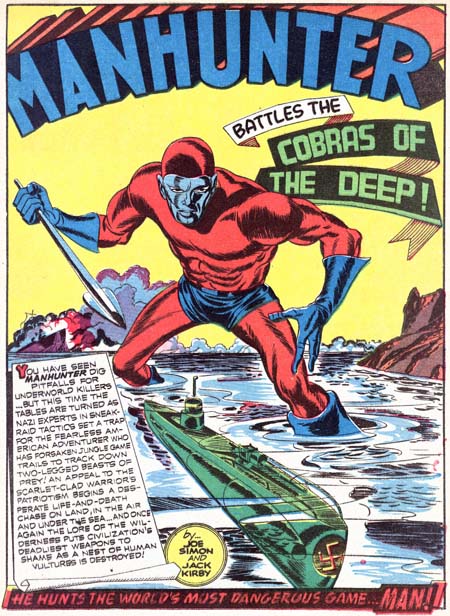 A German submarine is hiding off the Eastern US coast, about to undertake a special mission. The men have been tasked to destroy Manhunter, before he can sabotage their operations in and off the coast of the United States. they release balloons with messages attached, addressed to Manhunter. Children catch the balloons and one makes its way into Paul Kirk's hands. He calls a phone number listed in the message and is told to come to a lifeguard tower, on a nearby beach. he suspects a trap and goes and narrowly misses being blown up on the tower. he finds diving helmets, used by the sub crew to come ashore, secretly. After dispatching the Germans, he dons the diving helmet and heads underwater. he discovers the large submarine and tries to sneak aboard; but, is trapped in a net. he is dragged aboard and told that the sub is a tanker, to refuel other subs for attacks on shipping and coastal installations. he's locked ina compartment to await his fate. Manhunter takes things into his own hands, pouring bags of flower into the oil lines, then breaking out of his prison, wreaking havoc across the ship. he is able to sabotage the subs and, with the help of Navy, is able to capture the German subs. This story is a lot of fun, filled with the dynamic action you expect from Simon and Kirby. You can see the influence of their earlier Captain America stories. The tale would inspire later, modern stories with Paul Kirk, in his younger days, when he teams up with Dan Richards, the Quality Comics Manhunter, and the All-Star Squadron to attack a Nazi base in Africa. James Robinson then used Kirk as a key character in The Golden Age, and in the JSA mini-series, that set up the return of the regular series, where Manhunter and Huntress/Tigress attack the Nazi African base (from the Young All Stars story), while the JSA members come across them, in an attempt to stop the Stalker's henchmen. These were all bang-up stories and I would love to see someone take a crack at more war time Manhunter stories; preferably Robinson. |
|
|
|
Post by codystarbuck on Oct 22, 2016 19:42:00 GMT -5
Chapter 5, "Cathedral Perilous." 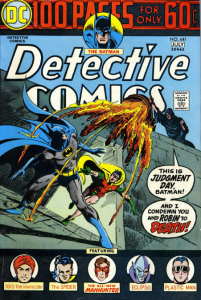 This has another groovie Jim Aparo cover and features a Batman story from Archie and Howie Chaykin (yay!), with the debut of Harvey Bullock. We also get a rare glimpse at Quality Comics' The Spider, aka Alias, The Spider, who would be retconned as a Ludlow and enemy of The Shade, in Starman. We also get a Jack Cole Plastic Man reprint and an early Eclipso. However,we are here for Manhunter. This where things pick up, as Manhunter and Christine St Clair have some clues to point them towards the Council's operations, and they have discovered they are wanted by international law enforcement. They are now in Istanbul, (was Constantinople, now it's Istanbul, not Constantinople), at the Romulus Cathedral. Archie tells us this cathedral has been plagued with violence and madness, since the Byzantine era. Perfect site for a battle. While our heroes take out a couple of monks (and not on a date), an American family is wandering around, checking out the sights. the youngest, a boy after my own heart, is decked out in cowboy gear and shooting his cap pistols at everything. Paul and Christine put on the monk robes and go searching, where they find a gathering of others, where we meet other agents of the council, who await an address from Dr Mykros. There is a question of succession, after Damon Nostrand's death and we learn that Dr Oka was murdered by Mykros, because he began to doubt the Council's mission. An alarm goes off, alerting Mykros to the presence of a recording device and all hell breaks loose (on holy ground, no less). Manhunter gets the drop on Mykros; but, the call has gone out to send in the clones (sorry...) and Walt gives us a fight that rages through, outside and on top the cathedral. meanwhile, the little boy, Nico, is watching this, in amazement; but, Mom and Dad don't listen when he tries to alert them He sees Manhunter cornered by a clone, who has him dead to rights; but, a well placed cap gun, thrown from above, makes the clone lose focus and Manhunter takes him out with a savage kick to the face. The cap gun then gets tossed back to Nico, whose parents are calling him. We end with Manhunter escaping, while Dr Mkros tasks one of the gathered Council agents to hunt Christine. he says it will be no problem, since he is her father! Dunh-duh-dunn!!!!!!!!! Walt really gets to have fun here, with the architecture of the cathedral, some comedy with the American tourist family, plenty of action, and some dizzying perspective. Archie fills in more back story about the council and their agents. This story went on to win the Shazam Award (presented by the Academy of Comic Book Arts) for "Best Short Story of the Year," for 1974. Chapter one, "The Himalayan Incident," won it the year before. The American family would pop up again, at Marvel Comics, in Thor (in 1985, somewhere around #360, give or take an issue or two), as well as an issue of Blue Devil. Well travelled clan. Anyway, this a great mixture of action and fun and serves to move our players closer to their goal. This was also the point that Archie took a job at Marvel. In discussing things with Julie Schwartz, Archie learned that he had no plans for Manhunter, so Archie and Walt could actually do the rare thing and give the story a conclusion. From this point on, everything is leading to a final climax. 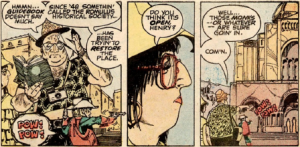 That was me, as a kid. I had enough toy guns to outfil a platoon. 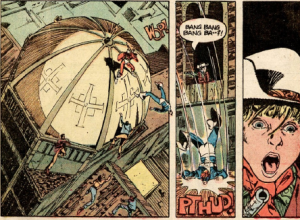 Walt's awesome bird's-eye shot of the battle atop the cathedral. |
|
|
|
Post by codystarbuck on Oct 22, 2016 20:03:13 GMT -5
Chapter 6, "To Duel the Master." 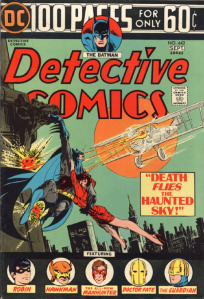 Jim Aparo gives us a hum-dinger of a cover, though I have to wonder how the lady's body is leaning that far out (nice stems, too). This issue features the seminal Batman story "Death Flies The Haunted Sky," by Archie Goodwin and Alex Toth, which was reprinted in the first Greatest Batman Stories Ever Told, Batman in the 70s, the Archie Goodwin Tales of the Batman, and the 75th Anniversary Batman retrospective book. That's some pretty heavy company. Manhunter is pretty good, too. 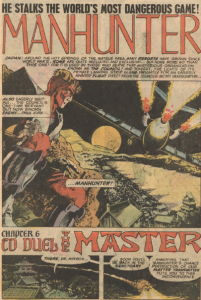 In this chapter, Manhunter is in Japan, chasing Dr Mykros, hoping to find the secret Sanctuary of the Council. While Manhunter stalks Mykros' group, he encounters his mentor, Asano Nitobe. he is there to delay Paul from stopping Dr Mykros, and kill him, if he must. They square off for a fight. Meanwhile, Christine is on the Orient Express, headed for Zurich, when she encounters her father, who tries to convince her to give up the audio recording of Dr Mykros talking about the Council's plans and the death of Dr Oka. He tries to make her believe he can smooth things over and save her; but, she refuses to believe him, forcing him to turn a gun on his daughter. She stares him down and he falters, letting her leave. We see him depart the train, in Sofia, Bulgaria, where he is gunned down.. 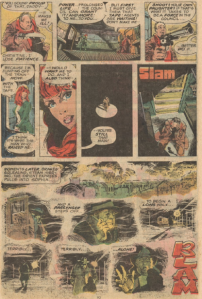 The scene reverts to Paul and Asano, who begin their epic battle. Walt gives us panel after panel of strikes and counter-strikes, weapon against weapon, bare hands and feat against the same. Manhunter is outclassed and finds himself at Asano's mercy, who is about to deliver a mercy-granting killing stroke, when a helicopter, with Christine in it, blasts Dr Mykros confession out a loudspeaker. Asano learns the truth about the Council and how Mykros had his master, Dr Oka, murdered. His duty to the Council at and end, Asano vows to help Christine and Paul destroy the Council. 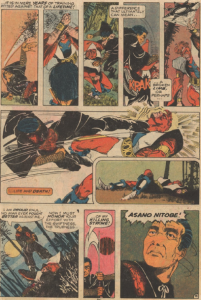 This is almost all action and Walt really gets to shine, with martial arts, acrobatics, and shots of weapons flying to and fro. he plays up the atmosphere, on the train sequences, while giving us the desperation of Manhunter's fight with his teacher.. This is probably the best action of the series. The ending is a little convenient; but, Archie has only one more issue to wrap up the tale. And, it will be a spectacular one. Of an interesting note is Asano's fightin gear. He wears mostly what we have come to think of as ninja attire; but, with a demonic mask. These style of face masks were often used as part of a samurai's armor, protecting their face, while also inducing fear in an opponent. It works well here and gives Asano a unique look. It's also interesting to see the hero entirely outclassed, even with his healing abilities and formidable weapons. for all of his training, Asano is still the master. this is a rare battle, for comics. |
|
|
|
Post by hondobrode on Oct 22, 2016 23:49:47 GMT -5
I've got to re-read this again someday.
I know it won a ton of awards back in the day.
|
|
|
|
Post by codystarbuck on Oct 23, 2016 11:44:16 GMT -5
I've got to re-read this again someday. I know it won a ton of awards back in the day. I was going to get to that; but, I'l just do it now. The Academy of Comic Book Arts was formed in 1970, as a professional organization, dedicated to promoting the art form of comic books. It was made up of comics pros from across the industry. Their goal was to be to comics what the Academy of Motion Picture Arts and Sciences is to Hollywood. Their "Oscars" were the Shazam Awards. The first chapter of Manhunter, "The Himalayan Incident," won "Best Individual Short Story (Dramatic)" and Archie won "Best Writer (Dramatic Division)." Walt Simonson tied with Jim Starlin for "Outstanding New Talent." That was for the 1973 awards (presented in 1974). The next year, Manhunter was back for more. "Cathedral Perilous" won "Best Individual Short Story (Dramatic)," "Gotterdamerung" won "Best Individual Story (Dramatic)," Archie again won "Best Writer (Dramatic Division)." Of note is that Archie was nominated twice for "Best Individual Short Story:" for "Cathedral Perilous," and for "Burma Sky," with Alex Toth, in Our Fighting Forces #146. Archie beat out Roy Thomas in both `1973 and 1974, when both of these writers were cooking (Roy on Conan). The Shazam Awards were the Eisners of their day; but, the ACBA ceased operations in 1977. Archie was a known talent, having garnered attention at Warren with great story after great story (especially in Blazing Combat, in which he wrote nearly everything); but, he was really doing some outstanding work here. After he went to Marvel, he spent more and more time as an editor and less as a writer, so it's often overlooked how great a writer he really was. Then, he'd do a story here or there and remind you of his brilliance. Probably his biggest contribution at Marvel, from a writing standpoint, was Star Wars. Archie gave that series life, after a somewhat jokey start from Roy Thomas (after the adaptation). Archie really played with the universe that George Lucas gave us and presented the biggest and most consistent body of work, outside the films, for the time, between the comic books and the newspaper strip. For my money, he is the best Star Wars writer, even better than Allen Dean Foster. Walt was a young turk and he set everyone on notice here. He hadn't done that many assignments. It took time, as he produced great comic after great comic in the 70s, then became WALT SIMONSON, in the 80s, with Thor. One of the joys of the Bronze Age is seeing young talent like Walt, Howard Chaykin, Bernie Wrightson, Mike Kaluta, or Jim Starlin do great single issues of a comic, which you enjoyed more than the regular teams, then start to get more high profile assignments, then become superstars, by the 80s. They really helped bring some new life into comics, which got their best platform in the dynamic period of the 80s, when the Direct Market opened up new publishing avenues and even old companies, like DC, really stepped up their game and took chances. Archie was a big part of that, via his stewardship of Epic, giving these young talents and even some older ones, a platform for doing more mature work and a chance at ownership. Archie's greatest legacy is probably not his writing, as great as it is; but, his time as a guide and mentor to a lot of talented people. He helped make the good great and the great awe-inspiring; and he did it without ever seeming to make an enemy. That's a heck of a legacy for an editor at DC or Marvel and he did it at both. |
|
|
|
Post by codystarbuck on Oct 23, 2016 15:00:23 GMT -5
Chapter 7 and Finale, "Gotterdamerung!"  Jim Aparo gets the cover, where our two main stars finally collide. It's Aparo's usual great work, though you do wish Walt could have gotten a chance at it. Now, Batman and Manhunter come together, as our story reaches it's climax. The beginning is all Batman, as he investigates the death of a friend, Dan Kingdom, a martial artist and ex-soldier, as well as foils an attempted assassination of a progressive African leader. Batman loses the assassin, thanks to intervention by the masked Enforcer. He is able to recover the rifle the assassin had. After consulting a criminal name Mole, Batman traces the rifle to Kolu Mbeya, in Nairobi. the scene shifts to nairobi, where Paul and his allies, Christine and Asano Nitobe, are trying to convince Kolu Mbeya to join the in an assualt on the Council's Sanctuary. He rebuffs them, saying he makes weapons, not uses them to storm fortified strongholds. As Kolu examines a telescopic sight, he sees the shape of Batman. Batman is being eyed by someone else, the assassin from Gotham. However, as the killer has Batman in his sights, in steps Manhunter. The assassin flees in terror, falling into Batman's arms, seeking his protection, as Manhunter's bullet strikes home. Now, our heroes meet and Batman isn't happy. Paul picks up a knife and shows Batman he was moments away from death. The two make a wary peace and Batman meets Manhunter's other allies, while Kolu decodes to join. Batman decides to throw in; but, manhunter rejects his help. it's a killing mission, he says, and he has no room for someone who isn't willing to take a life. Christine agrees and the group heads off, leaving Batman behind. 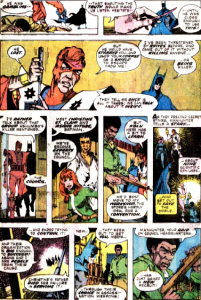 The team of four heads to teh Australian outback, where the Council's base is hidden below ground. As they travel, we learn Paul's motivation in his fight. he was weary of death and killing, after WW2 and was not happy to have his life preserved by the Council. he seeks to destroy them for disturbing his peace. This is a man on a suicide mission. As the group lands, Kolu is hit by a sniper and they come under fire. It suddenly stops, as Batman emerges with two unconscious Council soldiers. He and Manhunter agree to an alliance and the group enters the underground passages to the central area of the Sanctuary. Asano leads them inside, where they encounter the Enforcer. Batman rescues Manhunter from his assault, then tells them to move on, as he will deal with the Enforcer. Batman has deduced the Enforcer's identity and his role in the death of Dan Kingdom, his initiation as Paul Kirk's replacement. Batman fights martial skill with martial skill. Meanwhile, Paul and Christine head for the Council's main chamber, where Manhunter stops Christine and tells her he must do this alone. There he faces Dr Mykros, who has the Council's ultimate weapon, a device that can harness psionic energy and use it to control other energy and radiation. Paul's healing ability is put to the test as he is hit by a wave of radiation. His friends and Batman have their own struggle, against the numbers of the Council's soldiers. With the help of a revived Kolu, they are able to make their escape. It's just in time, as Paul has reached Mykros and taken the helmet, activating the destruction of the Council. We end with the survivors departing, with Paul assumed dead within the destruction of a massive explosion, which Walt renders in pure majesty. The story ends with pin-ups of Manhunter and Batman, by Walt Simonson. 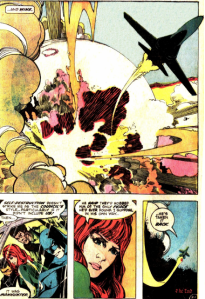 This one is epic, with mystery and action, from both Batman and Manhunter, and in conjunction. For the most part, the two heroes fight separately, so we are left to wonder who was the better combatant, which is just as well. Since Archie was leaving and no one else wanted to continue the story, we get a real, final ending. Our hero finds the peace he has sought. Archie gives us enough reasons to believe Paul is dead, from the radiation and the massive explosion, and his desire to die. This is mature stuff, from an era when comics were decidedly written for kids. The amazing thing is that the death was honored, when just about every other character gotten a resurrection, eventually. Paul Kirk has been allowed to rest in peace, though Archie gave us some ambiguity, since we never see a dead body; plus, Paul had the healing abilities. You'd think someone would want to use that to return this wonderful character. Instead, we got other Manhunters. We also had the the interesting idea of the clones, which will bring me to future connections. At this point, there is little more to say about Archie's writing and Walt's artwork. Walt really grew across these seven issues and he was ready to take on anything. Archie was the master storyteller. If I have one quibble it's that the Enforcer's uniform bears little connection to the Council (which may have been deliberate, for the beginning of the story; but, it also isn't particularly eye catching. It's a weird mix of green, red, brown and gold, which just doesn't work. It looks more like something for a background character in Kirby's 4th World. Also, Dan Kingdom never really is a full character in the story. he is more a plot device, than anything else. You wonder what Archie would have done, if he hadn't taken the job at Marvel. Would the story have reached such a finality? would Dan Kingdom have ever entered the story? Would Manhunter have defeated the Council, while finding a reason to live? Would we see a romance between Paul and Christine? Those are questions for debate and fan fiction. Instead, the story concluded and our characters, apart from batman, were not to be seen again. or were they? Next, I will take a look at a few continuations of the Manhunter legacy, some deliberately connected, some marginally. So, did I convince you this was the greatest adventure comic? For me, it has everything. It's a superhero, crossed with a pulp adventurer, crossed with James Bond, with martial arts thrown on top. It has mystery and intrigue, all-out action and combat, well sketched characters (mostly), and great pacing. I will admit that the ending is a little rushed and the first half is the stronger of the two; but, this is a master class in storytelling. |
|
|
|
Post by codystarbuck on Oct 23, 2016 16:42:57 GMT -5
     Two years after the end of the Manhunter saga, we see a new Manhunter appear, looking like Paul Kirk. however, it is quickly made clear it is a clone. it occurs in the new Secret Society of Super-Villains, from Gerry Conway and Pablo Marcos. We get the interesting concept that a group of villains are brought together, complete with a secret headquarters (inside a high-rise) by the mysterious Manhunter, at the behest of another. This group is convinced that by uniting their skills and abilities, they can defeat their enemies and rule. However, their benefactor remains hidden. He is revealed to be Darkseid, who plans to use the Society to launch attacks on Earth, discarding the previous Intergang. However, Manhunter convinces the Society that they will only be pawns of Darkseid and will never share in the conquest. he is able to turn them against Darkseid and his minions. In a climactic fight, we learn that the Manhunter clone carries a special secret: he is a living booby trap. he sacrifices himself to seal up Darkseid's Boom Tube and prevent further attack on Earth. It started with a nice idea; but, as with many DC books of the era, it quickly lost its way. Gerry Conway only did the first couple of stories and it switched between writers, creating a bit of literary schizophrenia. The book was all over the place. It had moments; but, it never really came together. It did bring back Captain Comet, who ends yup as a sort of enemy/ally. Unfortunately, this was the end of the Manhunter clone. It's just as well as he wasn't the same in other hands. Gerry Conway was busy playing with other people's toys, in this era, on the revived New Gods and the JLA. Quite frankly, he usually didn't measure up. He had some good JLA stories; but, his New Gods was a pale imitation. Steve Engelhart did a far more interesting job on Mister Miracle, with Marshal Rogers and Michael Golden. Conway had Don Newton, for some nice art, on Return of the New Gods; but, it never quite rose to epic. It's kind of the same here. Pablo Marcos provides decent, if unremarkable art. However, Conway left early and it seemed like no one knew where to go with this. It's not quite epic, though it has moments. It's just as well that the clone is sacrificed. manhunter was a unique series and I think most at DC respected the work Archie did and left well enough alone. Years later, Kurt Busiek returned to the idea of a surviving clone, in Power Company, with Kirk DePaul).   Busiek cleared the idea with Archie Goodwin, who told him to go for it. The idea of a Manhunter clone is better explored here, as one of the elements is the clone's attempt to live up to the legacy of his genetic father, Paul Kirk. It made for a far more unique character. Unfortunately, he was sacrificed in the later Mark Andreko Manhunter series, carrying on DC's then-tactic of killing off interesting characters to launch new versions. I like the Kate Spencer stories; but, losing Kirk DePaul was a bad idea. Mark Shaw does continue; but, I'm not much of a fan of how he was used beyond John Ostrander. Kurt Busiek was on to something, something that Conway must have seen; but, couldn't quite execute. It does leave us with the question, did more clones survive the original series? Well, Archie and Walt would address that, in our next installment. |
|
|
|
Post by Prince Hal on Oct 24, 2016 12:13:09 GMT -5
This is an excellent thread, Mr. Starbuck. Love the in-depth nature of your reviews.
Keep 'em coming! There must be another series you enjoyed.
|
|
|
|
Post by codystarbuck on Oct 24, 2016 22:36:40 GMT -5
This is an excellent thread, Mr. Starbuck. Love the in-depth nature of your reviews. Keep 'em coming! There must be another series you enjoyed. Oh, I have some ideas for more reviews/discussions. I was particularly thinking about taking a look at my namesake and his forefathers/cousins/descendants. Gives me a reason to re-read some classic Howard Chaykin. |
|
|
|
Post by codystarbuck on Oct 24, 2016 23:33:10 GMT -5
Coda:"Manhunter: The Final Chapter."  In The Manhunter: The Special Edition trade paperback, Walt Simonson tells the origin of our final story. Archie had been approached about doing a new Manhunter story, from the moment he came back to DC. Neither he nor Walt were keen on the idea and felt it would undermine the original, which had a definite ending. Then Walt says, Archie grabbed him and pulled him into his office and told him he had an idea about a story that would uphold the original and still explore some of the ideas, in a new day. Walt was jazzed and went home to start doing some research. Then, on March 1, 1998, Archie passed away, finally succumbing to the cancer he had been fighting for the past decade. 10 years of battling cancer; that's a tough man! He left behind an unfinished story and an incredible legacy. Tributes came from all corners and all spoke in loving memory of a man who seemed to be universally loved, who inspired people to work up to their full potential, who taught them so much, and who had so much fun in life. He never seemed to make a single enemy, in a business driven by egos. This giant of a talent drew respect, rather than jealousy. James Robinson spoke in loving detail how Archie's guidance made Starman the best superhero comic of the 90s and how his passing greatly affected Robinson, personally, and the direction of the book, in his absence. So, what was Walt to do? Weezy (wife Louise Simonson) suggested doing it as a silent story. It was Archie's plot, so his voice would still be there, even if his words weren't. Walt latched onto the idea and ran with it.  Our story begins with a bird's-eye view of Gotham, as shots ring out. Police are out in force, including Commissioner Gordon, who pulls a female reporter out of the line of fire. Searchlights scan the heavens as one of the SWAT team members points upward. We see one silhouetted figure leap from one building to another, followed closely by two more. Gordon orders his men to pursue. We move to a rooftop and see the legs of a figure drop onto it, turn and fire a Mauser pistol, then take off. The man wears the uniform and carries the weapons of the fabled Manhunter. We see a woman, firing a pistol at the fleeing man, while a masked ninja drops by her side. They pursue their quarry as we see a gloved hand move into frame, one with three scalloped edges to his glove. We pick up the action later, at a seedy hotel. A familiar figure stares out at the sinking sun, then gets dressed for business.  Just then, the door is kicked in by the armed woman. She draws a bead on our costumed figure, then hesitates, astonished. She sees the figure of Paul Kirk, Manhhunter, her friend. He pulls his Mauser and fires. The woman is Christine St Clair and she has been shot at close range. Manhunter stands over her, looking like he is about to deliver the coup de grace, when shuriken come flying at him, narrowly missing. Manhunter fires, then leaps out the window. The ninja sees him go, then attends to Christine. She is alive and reveals her kevlar vest, which saved her life. This appears to be past. As we return to the present, we see a bridge, then watch as Manhunter drops to a car roof and fires, then flees again.  Christine and Asano Nitobe follow, pursuing Manhunter to one of the bridge support structures. There, Christine is snared from above and pulled off her feet. Asano turns and sees her dangling, with Manhunter's katar pointed at her throat. He takes aim at Asano, when a familiar bat shape passes across his face. Asano moves and leaps, as Christine uses the distraction to launch a fierce kick, knocking Manhunter off balance and the katar from his hand. Asano hits him with a dropkick, sending him over the edge, plummeting to the bridge below. We see the body lying in a pool of blood and meat, on the pavement, as Batman, Asano and Christine look down. Batman confronts Asano, who removes his mask, then an object springs from his sleeve. It appears, at first glance to be a weapon; but, it's a brush. Christine holds out a paper with faces on it, with red Xes over them. Asano crosses the last face with a new X. He drops his mask, as Christine crumples and drops the paper. Suddenly, lights fill the scene and an Apache helicopter gunship appears, with Kolu Mbeya at the controls. He has weapons aimed at Batman and two lines drop down. Asano and Christine leap for them and the helicopter departs with the trio. Batman readies a batarang to throw, then thinks better of it and watches the group depart. Jim Gordon appears on the scene and seems to chastise Batman for letting the three killers depart. Batman points to a sign on the bridge that says, "Gotham City Limits." He then goes over and picks up the crumpled paper and demonic mask. He unfolds the paper and begins to tell Gordon the story of Manhunter, beginning with page one of Chapter one, "The Himalayan Incident." This is a fantastic tale and a fitting tribute to Archie Goodwin. We pick up the thread of the last Manhunter clone. At first we think it is Paul, pursued by others, then his former friends. We soon realize it must be a clone We get a flashback (assuming that the change in color scheme and the sight of the setting sun mean the scene is from earlier in the evening, before the pursuit). We get breathtaking action and a dizzying array of shots, from different angles. This is Walt after decades of experience, doing things his younger self was only beginning to understand. Archie gives us the feel of the original, while also wrapping up that last dangling thread. We have seen a Manhunter clone before, in Secret Society of Super-Villains and were left wondering if there were more. Archie answers this and, with the final X, we are led to assume the story is now over. the Council is gone and their legacy is now finished. Manhunter can finally rest in peace. In a fitting end, we loop back to the beginning, where we can see it all play out again. Walt and Archie gave Paul Kirk a fitting end and Archie and Walt provide us with an end for Manhunter, which also serves as a eulogy for Archie's talent. The man who spent a lifetime assuring people he was not joking, that his name was really Archie Goodwin and that he was not Nero Wolfe's assistant and confidant, demonstrated, with just a plot, how you tell a story. Walt took that plot and crafted a visual masterpiece. Here endeth the saga. RIP Paul Kirk. RIP Archie Goodwin. Long live Manhunter! Next, we will take a look at the Manhunter family, that came after Paul Kirk. |
|
|
|
Post by codystarbuck on Oct 26, 2016 14:23:12 GMT -5
Long Live Manhunter! So, Manhunter is dead, killed in the explosion that destroyed the Council's Sanctuary. That's the end, right? Ah, grasshopper; this is comics! 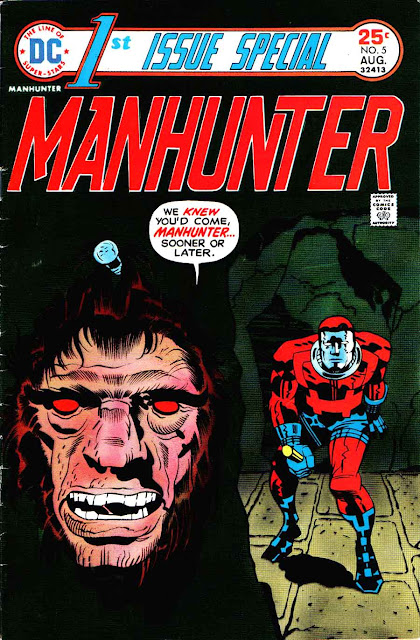 A year after Paul Kirk's demise, we see a new Manhunter, in First Issue Special (more accurately, Only Issue Special) #5, from Jack Kirby. Our story opens as we see a rather grisly head, and a red-suited man entering a cave:  As the Manhunter himself tells us, he has found the Cave of the Talking Heads and his quarry: David Byrne! However, instead of a man in a really big white suit, we see disembodied heads chattering, warning Manhunter to go back, then death traps. They don't stop our her, though, and he faces Chopper, the man with the Mardi Gras head!  A battle ensue and Manhunter destroys Choppers machinery, only to have a really big helmet dropped on him and thousand of volts shot through his body. A couple of well placed shots from his baton destroys the controls and hit Chopper. Chopper realizes he has been hit by paralysis bullets and decides to end matters with his own hands, before they fully take effect. he strikes with an axe; but Manhunter blocks with the helmet, electrocuting the criminal. Manhunter slumps against a wall to catch his breath and removes his expressionless mask, revealing an old man underneath. The scene shifts to a house, where public defender Mark Shaw debates with his uncle about the law of the jungle and the law of justice. he is defending a petty criminal who he claims is taking the fall for bigger fish; but, laments the system that works against his client. Mark's uncle tells him about a secret brotherhood of defenders, who fought the warlords and criminals of the ages, the Shan. He believes that the Shan still exist, in the form of a Manhunter, whispered to have taken down criminals, in recent days. He gives Mark a medallion, which is supposed to allow him to communicate. 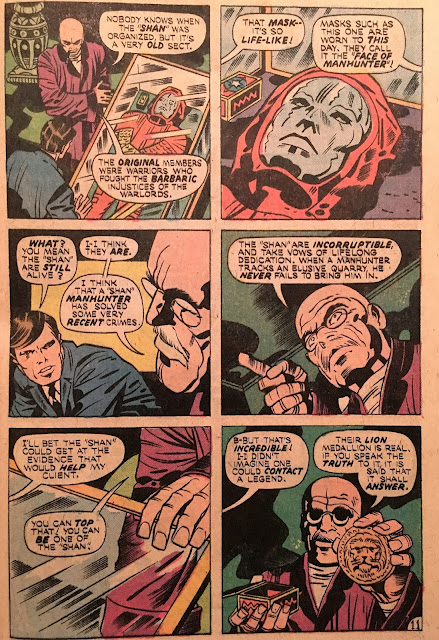 We shift back to the Manhunter lair, where the old man speaks to the Grand Master, leader of the Shan. he laments that he is the last of his kind, until a voice comes out of their lion totem. It is the voice of Mark Shaw. Back at Shaw's uncle's home, we see Mark dressed as Manhunter, telling his uncle he was right and now he can help his client. he remarks that the suit seems to add to his strength. His uncle grimly informs him that his client is dead. Mark vows to bring justice to those responsible. Just then, some hoods appear (in very 70s attire), and Kirby does what he does best:  The issue ends with Mark going after the criminal behind everything, the Hog, while the old Manhunter and Grand Master watch via monitor. We last see the Hogg, and then are asked, "Want to see the clash between manhunter and the Hog? If so, write and tell us!" Unfortunately, not enough people wrote in asking to see it, as that battle never followed. The issue is great, filled with Kirby's wild visuals and dynamic action. he packs a lot of detail in here, with a quick history of the Shan, the Manhunter brotherhood. We are kind of left to assume that Paul Kirk had been a member, in the 40s. Some have even inferred that the old Manhunter was meant to be Paul Kirk! Perhaps he was the missing Rick Nelson. What is clear is that Kirby is either ignoring the previous Goodwin and Simonson series; or, more likely, is ignorant of it. Whatever, jack rarely just picked up where someone else left off. He created something new (if not always original). The story has plenty of wonder. We see the amazing baton, which seemed to fire a variety of cartridges and the ability enhancing suit. there is some spectacular technology within this secret brotherhood! Why this didn't excite fans, I can't fathom. Perhaps it was due to the shoddy distribution and promotion of this title. Only two series were launched from its pages (Return of the New Gods and Mike Grell's Warlord) and only one (Warlord) survived the DC Implosion. It mostly seemed to serve to fulfill Jack Kirby and Joe Simon's individual contracts, without ever trying for a hit, despite some great concepts there (well, in Atlas and manhunter, anyway). Perhaps audiences just weren't able to keep up with where Kirby was going. Kirby in this period was somewhat controversial, hard as it may seem. When he came to DC, fans seem to expect something more like the heroes he created (or co-created) at Marvel. Instead, jack, never one to look back, was introducing wild new concepts and characters. he wasn't giving us Thor, he was giving us Thor's grandchildren, in a desperate battle against the ultimate evil. He gave us a demon on the side of good and the last human boy, in an apocalyptic future. He gave us a nightmare vision of a future, where a one man army fought those who would destroy; and he gave us a Manhunter, who was part of a secret brotherhood of guardians, dating back centuries. It was pulp, it was fantasy and mythology, it was science fiction and it was epic. And fans weren't ready for it, in large numbers. When Jack went back to Marvel, he did more of this, with the fantastic Eternals, and his gonzo Captain America. If Eternals was new Gods revamped for Marvel, Cap was OMAC. But the fans still weren't there and petty office politics plagued Kirby, driving out the most creative force the industry had ever seen. It is safe to say that without Kirby, modern comics wouldn't exist; at least, in the forms we know. Not just superheroes; but graphic novels, integrated titles and pure experimentation. So, instead, Manhunter slunk off to the bench, waiting for the coach to put him back into the game. That would come; but not in a Manhunter series. It would be in a different playing field. |
|